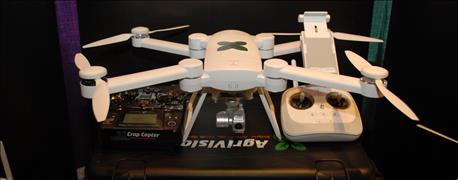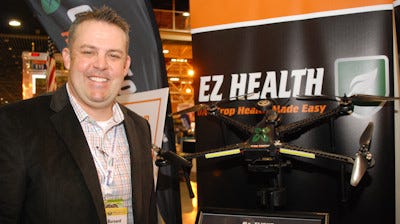
Itching to take your Unmanned Aircraft Vehicle for a test flight? Used correctly, UAVs are time savers, back savers and potentially money savers. But before your UAV’s maiden voyage across the cornfield, there are a few things you need to know, and do.
1. Is it in the box or in the air? That matters for UAV insurance.

LIABILITY? Matt Barnard, Crop Copter, advises farmers to check with their insurance company before liftoff with an unmanned aerial vehicle.
“Most insurance companies will physically cover the UAV as long as it’s in the case,” said Crop Copter owner Matt Barnard. “As soon as you physically take it out of the box and fly it around, there’s limited or no insurance coverage.” If needed, Barnard recommended sourcing coverage from an insurance company that specializes in UAV policies. He said for roughly $70 a year, farmers can obtain $1 million in liability coverage and coverage for the ship for roughly $300 - $500 a year depending on the UAV.
2. No registration? No coverage.
Barnard said most insurance companies will ask for UAV registration information in order to file a policy. “If insurance companies can help enforce registration, that’s a good thing,” said Barnard. “A lot of our customers get registered and insured.” Registration is different from filing for a 333 exemption, which requires a completely different pile of paperwork. UAV registration is required through the FAA before your first flight.
Related: Got a 400-foot ladder? How about a UAV?
3. 333 Exemption: State your purpose.

EXEMPTION NEEDED? Barnard recommends talking to your attorney if you have questions whether your flight is legal or not. Or, apply for a 333 exemption to be safe.
There’s a difference between capturing a scenic sunset for the mantle versus making a business decision. “For anything that would be deemed commercial use, whether you’re trading money or not, you need a 333,” said Barnard. “But if I’m a farmer and I fly a field and see a weed problem, and I do something about it, some people would say there’s a financial benefit to that.” Hence, the blurry line for whether or not farmers need a 333 exemption.
4. Filing for exemption = time and money.
Barnard said filing for exemption can be a daunting task. The exemption requires specific information about proposed use, area of operation, UAV used, as well as pilot, safety and UAV ship specifications. For many, this process is so overwhelming that some have lawyers handle their exemption. Unfortunately, that can cost upwards of $5,000.
5. May I see your license and registration?
That’s right -- you need a sports, private, recreation or commercial pilot license in order to file for a 333 exemption with current medical card. Or, you may hire a pilot to fly it for you.
Got all that? You need insurance, registration, to be a pilot and a 333 exemption if you plan on using your UAV to make input decisions. Talk about reading the fine print. That’s why Crop Copter introduced First Flight Initiative, a resource for farmers looking for further education, training and other useful tips regarding UAV ownership.
Farmers should also know the rules today may not be the rules tomorrow.
Barnard explained new legislation proposed by Illinois Congressman Rodney Davis would create different exemptions for small UAVs. According to a press release issued by Congressman Davis, “This amendment creates a new classification that would exempt micro UAS weighing up to 4.4 pounds from regulation under the FAA.”
For now, farmers need to follow current FAA rules and regulations. Barnard recommends visiting First Flight Initiative and doing your due diligence before flying a UAV over the back forty.
About the Author(s)
You May Also Like




